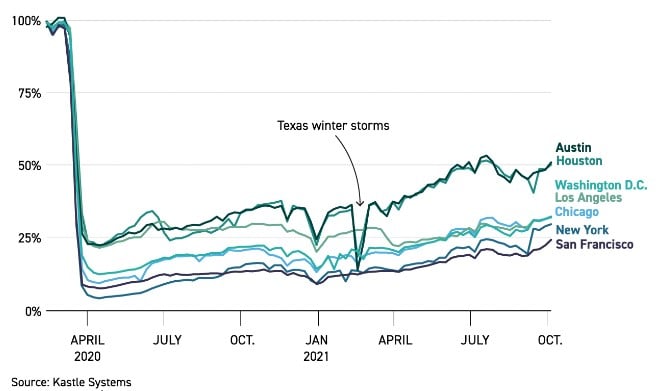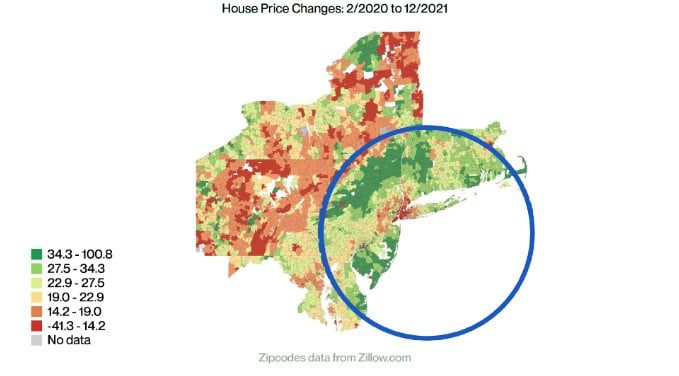As groggy remote workers begrudgingly open their laptops on a Monday morning, they’are greeted with desktop photos of stunning alpine vistas, pristine beaches and green rural villages. Thank you, Microsoft, for reminding us that there’s a much better world outside our apartments. Well, some of us are choosing to act upon our stock photo-induced FOMO. Having escaped office shackles (the unexpected upside of a pandemic), those desktop images have come to reflect a place we could potentially work from. Like wildebeest sensing greener pastures, remote workers are on the move. In fact, as many as 18.9 million Americans are reportedly planning to move because of remote work.

So where are they moving? Let’s take a look at the trends, and boldly hypothesize as to what this means for economic growth, population trends, and changing demographics. Spoiler alert: few people in their right mind are moving to the UK.
Where on Earth will people live in the future?
This is the name of a Ted Talk with Parag Khanna, a global strategist whose views are fortunately less vague than the title of his profession. Exploring the implications of climate change, nomadic lifestyles, ease of mobility and de-industrialization, Khanna makes some predictions on what lies ahead: “Mass migration, potentially on a scale we’ve never seen before.” Like Paul Morland, the author of The Human Tide, Khanna links steady population growth to the economic success and political stability of nations and empires. He claims governments are increasingly conscious of how population growth is essential to their country’s future. “[Nations] are going to be engaged in a war for young talent.”
So what are young people looking for? What will win over Steve, a 27-year old UX designer who spends the first half of his workday in a dressing gown? “Places that offer opportunity, work, particularly professional opportunities, educational opportunities, a decent quality of life, political stability, climate stability…the basic things,” says Khanna. “[Young people] are not loyal to nationality, they’re more interested in sets of values…right to connectivity, a sustainable world and mobility. Their own right to be mobile.”
The freedom granted by remote work is far from the only factor influencing migration patterns, however countries with declining populations have been quick to identify it as a prime opportunity to snatch some business-savvy talent from nearby nations. That ‘war for young people’ Khanna mentioned has – in some countries – already been going on for years, long before Aunt ‘Vid made her rounds. Consider Italy’s €1 house programmes. If you’re not scared of rats and know a thing or two about renovation, an abandoned home in a picturesque village like Sambuca and Mussomeli can be yours first just €1 (*cough* renovations will cost at least €50,000 *cough*).
How can a three-bedroom home in the land of tiramisu be so darn cheap? Because Italy is in serious trouble. With one of the oldest populations in the world, the government is desperately trying to entice young couples and single minglers to settle amid their olive trees and trattorias. The pandemic put Italy’s €1 house programme on hold, but the ensuing remote work revolution is only strengthening the power of their incentive. Canada has been accepting 300,000 immigrants per year since long before the pandemic. In 2021, the nation’s target was increased to 400,000 immigrants. That’s a lot of new people learning to say ‘eh’.
Competing nations
As of July 2022, more than 25 nations have launched ‘digital nomad’ visa programmes, or ‘residency schemes’, as a way of luring remote workers to their country. The visas give residents the ability to apply for ID cards, open bank accounts, and rent accommodation – all without paying any local income tax. For long-time digital nomads, this move is refreshingly accommodating, and simplifies aspects of mobile life they’d previously struggled with (being stuck in a so-called ‘legal limbo’). To qualify for the VISA, you’ll need to provide proof of employment and a minimum monthly salary which varies between countries.
Italy, Brazil, Malta, Bahamas, Croatia, Mexico, Iceland and Costa Rica are to name but a few countries helping normalize (and popularize) the wave of remote worker migration. Argentina will even offer discounted rates on flights, accommodation, and co-working spaces for those who wave their lucky Visas like Charlie waved his golden ticket. Meanwhile, Venice and Florence have launched programmes to ensure digital nomads have the smoothest possible landing when they arrive. Combine that with €1 houses and Italy definitely wins the prize for desperation.
So far, the implications are obvious: young people are taking their laptops abroad. What is perhaps a little less expected is that digital nomad migration is not exclusive to 20-somethings. The BBC reports on the ‘rise of digital nomad families’. That’s right – entire families are now hopping between countries simply because they can. But there’s a complication. Work may no longer be location-dependent, but schooling retains its traditional form. Families who settle somewhere only for a few years before moving on might offer children great cultural exchanges and continuous adventure, but their education will suffer unless better schooling options are offered to digital nomad families. Will the future contain fully remote schools, or ‘drop-in’ classes for kids that are passing by? Will it become easier to enroll in international schools in those countries hoping to attract migrants?
But can this trend really continue?
At this point you may be wondering: is all of this really sustainable? How do we actually know remote workers aren’t just going to get bored of their freedom? For some, remote work has not been the getaway into another lifestyle as it has been for others. Many find they’re made uncomfortable, not ecstatic, by the overwhelming choice in where to live. After all, when you can finally live anywhere, it’s painful to realize it’s actually laziness – not lack of opportunity – keeping you in your boring hometown. For every person insisting remote work has changed their life for the better, there’s about half a person mumbling something about actually rather missing the awkward office parties. Besides, plenty of big tech companies have shown they’re not going to give up their swanky offices without a fight.
Elon Musk snapped his sassy fingers in May 2022, demanding Tesla and SpaceX workers get their butts back in office, while Tim Cook of Apple is still referring to remote work as an ‘experiment’. This doesn’t sound promising. So is packing up and moving abroad really a viable option right now? Is it safe to give up the lease on our flats, and start scrolling Italy’s list of rat-infested homes? The long answer is that nothing in this godforsaken life is certain. But the short answer is yes, because no matter which way you flip the pancake, it looks the same. Remote work is here to stay.
Freedom too good to give up
Lying unshowered in bed while you listen to your boss’ quarterly update, the thought may have entered your head that your work life has changed rather dramatically in the past years. Sometimes it sucks, but the fact is that we’re getting used to it. We’re saving money that would have otherwise gone to long commutes, office attire, and overpriced lunches. We have more time for family, hobbies, errands, rewatches of all six seasons of Breaking Bad. A survey by IBM found that the majority of US adults want to keep working remotely post-pandemic:
- 54% of people working remotely now would like to keep doing so
- 75% of everyone surveyed would like to work remotely at least occasionally
Peak through the glass of an office building and you’ll see this preference reflected in empty desks. A study by Microsoft found that 66% of surveyed business leaders say their company is considering redesigning office space for hybrid work – where employers sometimes work remotely and sometimes in the office. Some employers – like Slack, Twitter and Square – will remain mostly remote for the foreseeable future.

The tricky trouble of timezones
Tragically, the best places on Earth do not share the same timezone. Picture it: your remote team mate wants to move to Thailand, but you’re keen on Costa Rica. Here’s the catch: you guys rely on having regular meetings together to get your work done. So who’s going to get up at 6am for a one-hour strategy call, and who’s going to click through a PowerPoint presentation at 7pm? The trouble of timezones might have been one of the biggest obstacles standing in the way of total mobile freedom for remote workers, except that some start-ups are suggesting solutions.
It’s called ‘async collaboration‘. Demanding employees attend every single meeting in real-time is no longer realistic or reasonable. To attract top talent, companies are realizing they have to be more flexible, because the future of work is one in which employees will be spread across continents and time zones. Knowledge workers will collaborate when it suits them. From creative brainstorming tools like Miro, to meeting recorders like tl;dv – proper documentation and asynchronous communication styles will be adopted across the modern workplace, until timezone differences are no longer an obstacle.
By normalizing a shift to asynchronous work, people from all over the world can collaborate more easily – just not at the same time. The result, of course, is even more freedom of mobility. But will these styles of working catch on? Will asynchronous communication become commonplace in the post-COVID world of work? Only time will tell, but as of now, many remote workers view a move to a different time zone as out of the question. When the 9am-to-5m becomes a 1am-to-9am kind of deal, remote work suddenly loses its appeal.
From cities to forests
A key aspiration among those on the move is to leave costly, highly populated urban areas. A 2020 UpWork survey of US citizens found that remote workers in dense urban areas were most likely to move. This is partially due to the fact that inner-city white-collar jobs tend to be more remote-friendly in the first place, but it’s also because urban life isn’t always the most idyllic. Desired destinations of migrating workers tend to be rural or suburban in nature. Not only is the grass greener in these places, but there is literally grass. A different UpWork survey identified the distances these remote workers are moving:
- 33% said they are moving a few minutes away
- 23% said they are moving within a 2-hour drive
- 13% said they are moving between two and four hours away
- 28% of people said that they are moving more than 4 hours away
Dunkin' economics
An indication of where these city workers are migrating can be found in housing market trends. Generally, the house market in urban centers has declined, whereas the prices of surrounding rural and suburban properties have increased. A starving economist has termed this pattern of movement as the ‘donut effect’.
The example depicted below is New York, with the blue line indicating the outer extent of the donut (i.e. New York residents moving range). The dark green areas within the donut show places where house prices have increased the most, due to greater demand. Long-time residents of these newly popular areas can brace themselves for an influx of Starbucks, craft beers and walking clubs. Don’t you just love city folk?

No worries, nomads
So what about the 28% who are willing to move over four hours away, or have already done so? Well, a portion of people within this cohort are dreaming big. The seed that Microsoft planted in their minds with that highly photoshopped desktop background? It blossomed. People are chasing their vision of a better, sunnier, healthier or at least more exotic life abroad.
According to a survey of 12,000 people by InterNations, one in ten readers have moved abroad as a direct result of the pandemic. That being said, InterNations is also a website on which expats flirt with one another under the pretense of ‘talking business’, so their readiness to move abroad may not reflect that of the general population. Either way, these people have been dubbed ‘COVID expats’ – a term they’re surely delighted by.
There’s a big chance this number of post-COVID expats is set to grow as employers flex remote working rules, meanwhile those of us staying put battle intense FOMO. A recent survey found that 62% of UK workers would consider moving abroad to work remotely. This may seem like a remarkable figure unless you’ve ever been to the UK, in which case it will make sense.

The times they are a-changin'
Nations are adjusting to the changing demands and migration patterns of remote workers in a post-COVID world. What will the implications be? Deserted urban areas? Populous Italian villages? Rising house prices in the countryside?
Will education adapt to the needs of digital nomad families, and will asynchronous styles of work become the new norm? One thing’s for sure: the coming years will give us an indication of how new migration trends may permanently change the make-up of demographics across the globe.





